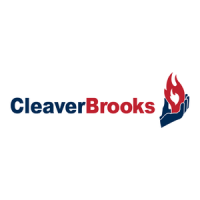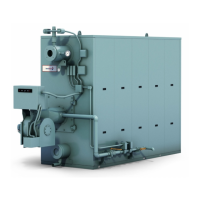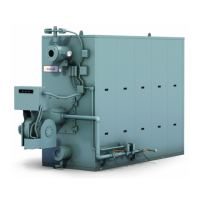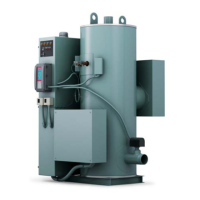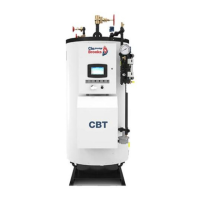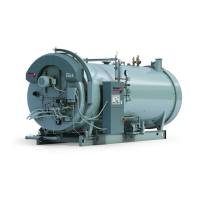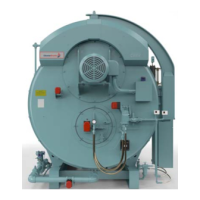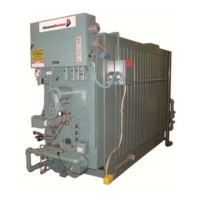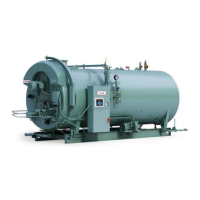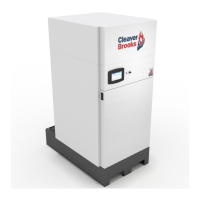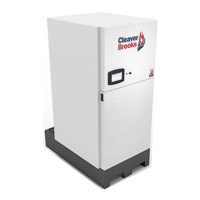Chapter 3 Pressure Vessel Care
3-6 750-177
Boiler Size
150-
250
300-
350
400-
600
700-
900
1000-
1200
Water Capacity (US
gal.) Hot Water
91 106 174 228 269
Water Capacity (US
gal.) Steam - Flooded
194 215 293 464 562
F. CLEANING
Although it may be necessary to clean the system,
information in this chapter deals primarily with cleaning the
boiler under isolated conditions.
System piping connected to the boiler may contain oil,
grease, or other foreign matter. These impurities must be
removed to prevent damage to the heating surfaces of the
pressure vessel. Chemical cleaning generally is necessary in
this case and the entire system should be drained after
cleaning. Consult your local Cleaver-Brooks authorized
representative for recommended cleaning compounds and
application procedures. For information on Boilout, see
Section G, in this chapter.
Pressure Vessel
Cleaning of the waterside of the pressure vessel should be
done during the course of initial installation. The waterside of
the pressure vessel must be cleansed of grease, sludge, and
foreign material. Such deposits will shorten the life of the
pressure vessel and interfere with the efficient operation and
function of control or safety devices. In addition, deposits
might cause unnecessary and expensive rework, repairs, and
downtime.
The pressure vessel and the hot water system represent in
effect, a closed system. Although individual components of
the system may already have been cleaned, it is possible that:
1. The cleaning was not adequate.
2. An old system was partially or totally involved.
3. Conditions may have prevented an adequate cleaning of
the piping.
Therefore, it is recommended that the entire system be
cleaned, after installation of all components is completed.
The pressure vessel waterside should be inspected on a
periodic basis. An inspection will reveal the true internal
conditions and will serve as a check against conditions
indicated by chemical analysis of the boiler water. An
inspection should be performed 3 months after the initial start
up, then at regular 6, 9, or 12 month intervals thereafter. The
frequency of periodic inspections will depend upon the
internal conditions found, the particular installation, and the
operating conditions that the boiler is subjected to.
If any deterioration or unusual conditions are observed,
contact your local Cleaver-Brooks authorized Representative
for recommendations.
G. BOILOUT
Any oil, grease, or other contamination found to be present on
waterside heating surfaces should be removed promptly by
boiling out the unit with an alkaline detergent solution.
Note: Before boiling out, the burner must be
ready for firing. Refer to CHAPTER 2 -
Profire V Burner.
There are several chemicals suitable for boilout. One
combination often used is soda ash (sodium carbonate) and
caustic soda (sodium hydroxide) at the rate of 3 to 5 pounds
each per 1,000 pounds of water, along with a small amount of
laundry detergent added as a wetting agent.
If the system is to be cleaned with the boiler, consider the
additional water content of the system in determining the
amount of chemical required. The water capacity of Cleaver-
Brooks FLX Boilers is listed in Table 3-4.
Boilout Procedure
1. Prepare the boiler for firing by taking the standard
precautions. Check for any situations that might present
a hazard.
2. Remove upper and lower drum handhole covers and
inspect all internal waterside surfaces. Remove debris
and wash all internal surfaces, including tubes. It may be
necessary to use a high pressure hose or a wash out lance
to flush out inaccessible areas. Reinstall the lower drum
Table 3-4: Water Capacity
UPPER HAND HOLE
DOWNCOMER
SYSTEM
INLET
SIGHT
PORT
Figure 3-5: Rear Panel (Hot Water Boiler
